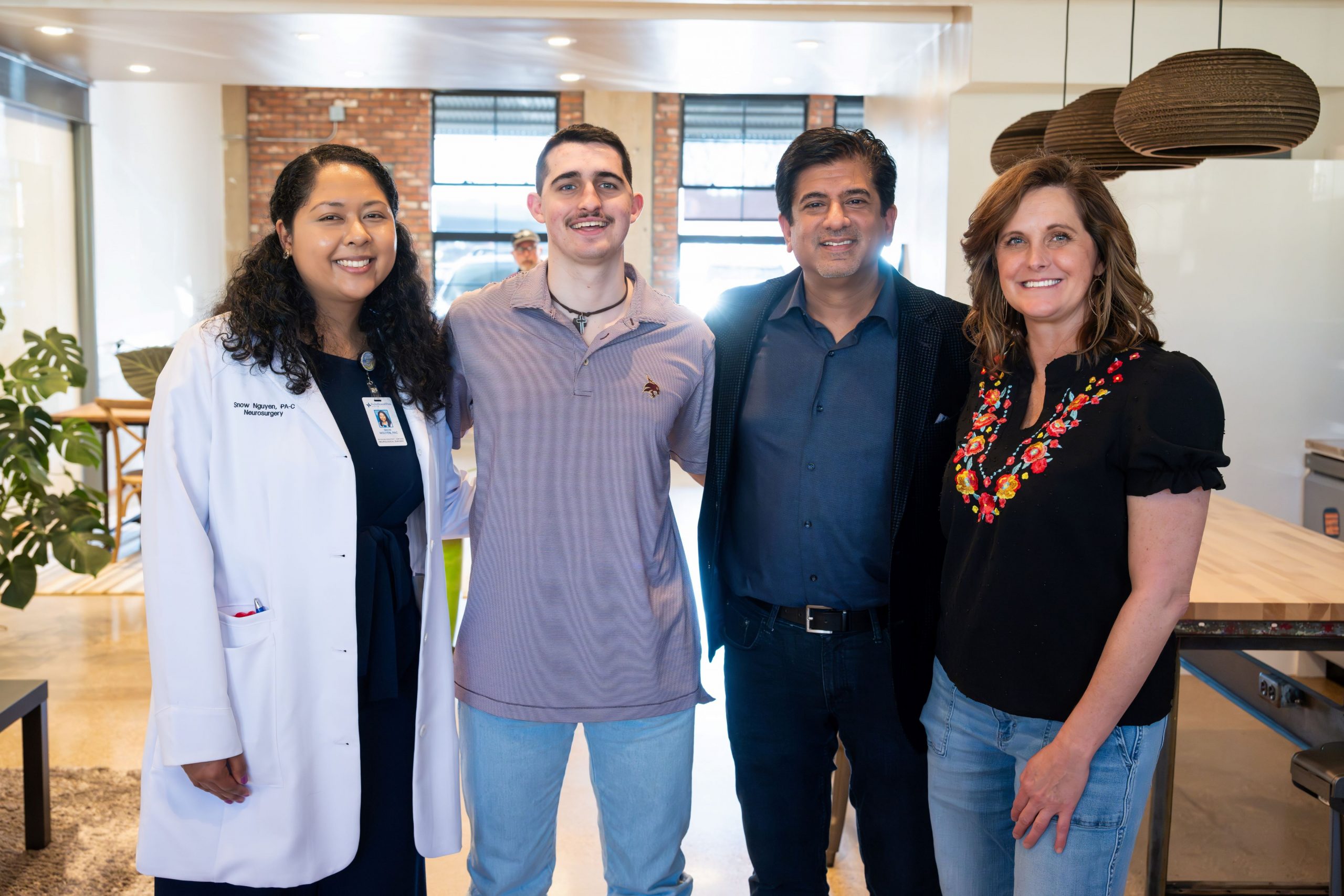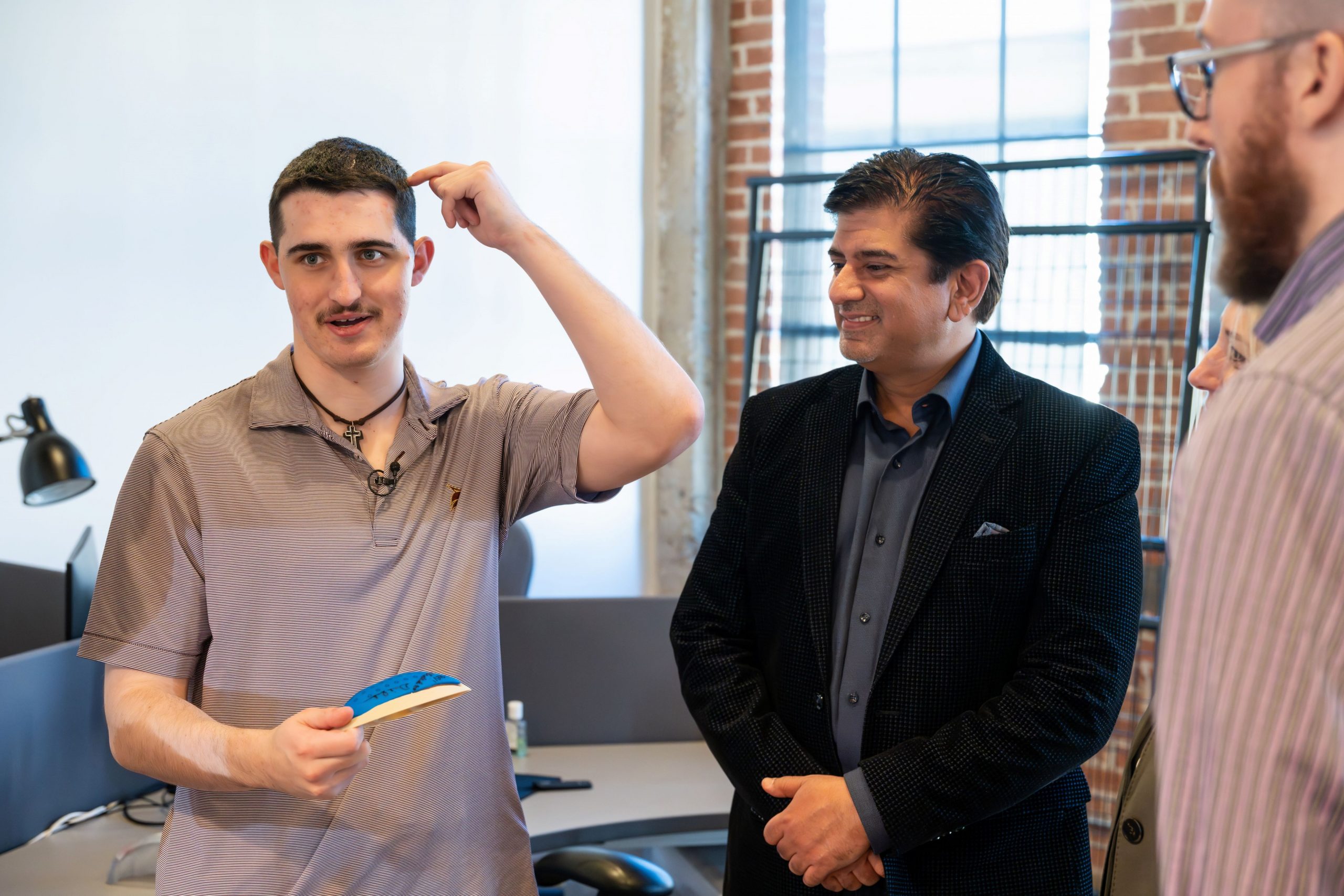
Dr. Snow Nguyen, Trevor Dutton, Dr. Shaad Bidiwala, and Wendy Dutton in the MedCAD offices
Wendy Dutton saw the car coming.
She was in a three-car caravan with her 17-year-old son Trevor and five other mothers and their sons, all on a Spring Break trip to Seaside, FL. They were stopped at a red light near Mobile, AL. Wendy watched, helplessly, as the driver came over a hill and slammed into the car behind
her—the one in which her son was riding.
She was out of her own car in a flash, pulling Trevor from the wreckage. He was alert for a moment, and then slipped into unconsciousness. A passing ambulance stopped to help, transporting Trevor and the other injured to University Hospital—the only trauma center between their Texas home and their beach destination, and a miraculous mere ten minutes from the accident.
Wendy prayed in the waiting room. Doctors emerged to say that Trevor’s brain was swelling and that they would need to remove a large portion of his skull or he would not survive.
That’s what they did. And Trevor not only survived, but is a thriving college-bound 18-year-old—though one with a little more biomedical plastic in his head than most.
“I remember nothing from Alabama,” says Trevor. He spent the better part of week in a coma there, and then took a ten-hour ambulance ride back to Baylor University Medical Center with Wendy at his side. “When I was finally capable of understanding where I was in the hospital in Dallas, I realized there was a giant dent in my head because of my skull missing.” Physical rehabilitation was hard on him; the accident had dislocated his femur and chipped his pelvis, and it took a while for his muscles and nerves to respond correctly. He also had to wear a protective helmet anytime he wasn’t in bed.
“I would surprise myself,” he says. “Every single time I took off my helmet, I would be like, ‘Oh yeah, you got a giant dent in your head.’”
“We had to go from a one-color helmet to another one for prom,” says Wendy. “We needed one that didn’t look quite so medical, because he refused to take some pictures in it. Just, you can imagine, I mean, he’s 18 and going to prom and in a wheelchair and with that helmet on.”
But prom was just one big event in a life full of events. Trevor and Wendy knew that wearing protective headgear wasn’t a life-long solution. Baylor referred them to Dr. Shaad Bidiwala, and Dr. Bidiwala got in touch with MedCAD.
A CT scan was delivered to the MedCAD offices in Dallas, and technicians got to work. In consultation with Dr. Shaad Bidiwala and his surgical team, they finalized a design that would fit perfectly in the gap left by the Alabama craniotomy. Next, they 3D printed from PEEK, a thermoplastic polymer, in the MedCAD production facility in nearby Plano.
“Implants for cranioplasty really get to the essence of what we do,” says MedCAD founder Nancy Hairston. “No two skulls are alike, and no two trauma sites are alike, so there just aren’t optimal off-the-shelf solutions. Our process matches exactly what the patient needs, and assures faster surgeries and better outcomes.”
“Originally, we wanted to ship my skull back from Alabama,” says Trevor, but that proved to be unworkable because of sterilization issues. “I think the prosthetic piece worked out better because there was a lower chance of infection,” he says.
Today, Trevor is a healthy and helmetless young man who is in the gym sometimes twice a day, working to regain the strength and flexibility the incident temporarily took from him. Just before Christmas, Trevor—along with his mom and Dr. Bidiwala—paid a visit to the MedCAD offices to meet with the team that created his implant and gave him back a normal life.
As they showed him around the lab and the fabricating machines, they also gave him a replica of the plate he’s currently carrying inside his head. That’s going to be a fun thing to show off at college.

—
2024 | MedCAD
